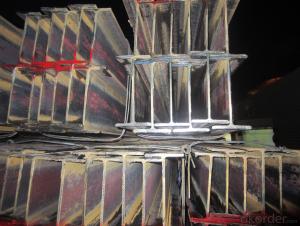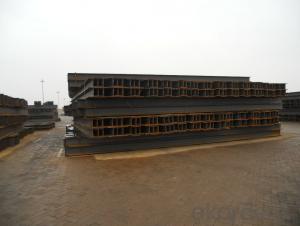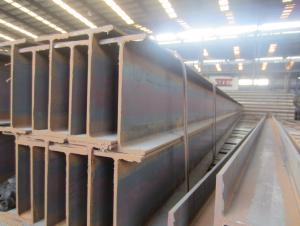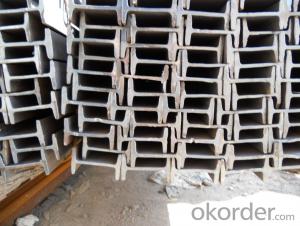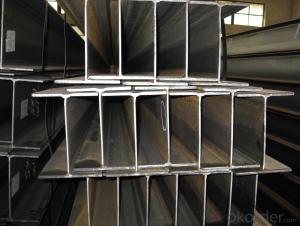High Quality Hot Rolled Steel Jis Standard H Beam
- Loading Port:
- Tianjin
- Payment Terms:
- TT OR LC
- Min Order Qty:
- 25 m.t.
- Supply Capability:
- 1000 m.t./month
OKorder Service Pledge
OKorder Financial Service
You Might Also Like
roduct Description:
Specifications of Hot Rolled Steel H-beam
1. Standard: GB
2. Grade: Q235 or Equivalent
3. Length: 6m,10m, 12m as following table
4. Invoicing on theoretical weight or actual weight as customer request
5.Payment: TT or L/C
6. Sizes:
Category | model (height*width)/ (mm×mm) | Section size/mm | Cross-section area/cm2 | Theoretical Weight/(kg/m) | Moment of inertia/cm4 | radius/cm | Section modulus/cm3 | |||||||
H | B | t1 | t2 | r | Ix | Iy | ix | iy | Wx | Wy | ||||
HW | 100×100 | 100 | 100 | 6 | 8 | 8 | 21.59 | 16.9 | 386 | 134 | 4.23 | 2.49 | 77.1 | 26.7 |
125×125 | 125 | 125 | 6.5 | 9 | 8 | 30.00 | 23.6 | 843 | 293 | 5.30 | 3.13 | 135 | 46.9 | |
150×150 | 150 | 150 | 7 | 10 | 8 | 39.65 | 31.1 | 1620 | 563 | 6.39 | 3.77 | 216 | 75.1 | |
175×175 | 175 | 175 | 7.5 | 11 | 13 | 51.43 | 40.4 | 2918 | 983 | 7.53 | 4.37 | 334 | 112 | |
200×200 | 200 | 200 | 8 | 12 | 13 | 63.53 | 49.9 | 4717 | 1601 | 8.62 | 5.02 | 472 | 160 | |
200 | 204 | 12 | 12 | 13 | 71.53 | 56.2 | 4984 | 1701 | 8.35 | 4.88 | 498 | 167 | ||
250×250 | 244 | 252 | 11 | 11 | 13 | 81.31 | 63.8 | 8573 | 2937 | 10.27 | 6.01 | 703 | 233 | |
250 | 250 | 9 | 14 | 13 | 91.43 | 71.8 | 10689 | 3648 | 10.81 | 6.32 | 855 | 292 | ||
250 | 255 | 14 | 14 | 13 | 103.93 | 81.6 | 11340 | 3875 | 10.45 | 6.11 | 907 | 304 | ||
HM | 150×100 | 148 | 100 | 6 | 9 | 8 | 26.35 | 20.7 | 995.3 | 150.3 | 6.15 | 2.39 | 134.5 | 30.1 |
200×150 | 194 | 150 | 6 | 9 | 8 | 38.11 | 29.9 | 2586 | 506.6 | 8.24 | 3.65 | 266.6 | 67.6 | |
250×175 | 244 | 175 | 7 | 11 | 13 | 55.49 | 43.6 | 5908 | 983.5 | 10.32 | 4.21 | 484.3 | 112.4 | |
HN | 100×50 | 100 | 50 | 5 | 7 | 8 | 11.85 | 9.3 | 191.0 | 14.7 | 4.02 | 1.11 | 38.2 | 5.9 |
125×60 | 125 | 60 | 6 | 8 | 8 | 16.69 | 13.1 | 407.7 | 29.1 | 4.94 | 1.32 | 65.2 | 9.7 | |
150×75 | 150 | 75 | 5 | 7 | 8 | 17.85 | 14.0 | 645.7 | 49.4 | 6.01 | 1.66 | 86.1 | 13.2 | |
175×90 | 175 | 90 | 5 | 8 | 8 | 22.90 | 18.0 | 1174 | 97.4 | 7.16 | 2.06 | 134.2 | 21.6 | |
200×100 | 198 | 99 | 4.5 | 7 | 8 | 22.69 | 17.8 | 1484 | 113.4 | 8.09 | 2.24 | 149.9 | 22.9 | |
200 | 100 | 5.5 | 8 | 8 | 26.67 | 20.9 | 1753 | 133.7 | 8.11 | 2.24 | 175.3 | 26.7 | ||
250×125 | 248 | 124 | 5 | 8 | 8 | 31.99 | 25.1 | 3346 | 254.5 | 10.23 | 2.82 | 269.8 | 41.1 | |
250 | 125 | 6 | 9 | 8 | 36.97 | 29.0 | 3868 | 293.5 | 10.23 | 2.82 | 309.4 | 47.0 | ||
300×150 | 298 | 149 | 5.5 | 8 | 13 | 40.80 | 32.0 | 5911 | 441.7 | 12.04 | 3.29 | 396.7 | 59.3 | |
300 | 150 | 6.5 | 9 | 13 | 46.78 | 36.7 | 6829 | 507.2 | 12.08 | 3.29 | 455.3 | 67.6 | ||
350×175 | 346 | 174 | 6 | 9 | 13 | 52.45 | 41.2 | 10456 | 791.1 | 14.12 | 3.88 | 604.4 | 90.9 | |
350 | 175 | 7 | 11 | 13 | 62.91 | 49.4 | 12980 | 983.8 | 14.36 | 3.95 | 741.7 | 112.4 | ||
400×150 | 400 | 150 | 8 | 13 | 13 | 70.37 | 55.2 | 17906 | 733.2 | 15.95 | 3.23 | 895.3 | 97.8 | |
HT | 100×50 | 95 | 48 | 3.2 | 4.5 | 8 | 7.62 | 6.0 | 109.7 | 8.4 | 3.79 | 1.05 | 23.1 | 3.5 |
97 | 49 | 4 | 5.5 | 8 | 9.38 | 7.4 | 141.8 | 10.9 | 3.89 | 1.08 | 29.2 | 4.4 | ||
100×100 | 96 | 99 | 4.5 | 6 | 8 | 16.21 | 12.7 | 272.7 | 97.1 | 4.10 | 2.45 | 56.8 | 19.6 | |
125×60 | 118 | 58 | 3.2 | 4.5 | 8 | 9.26 | 7.3 | 202.4 | 14.7 | 4.68 | 1.26 | 34.3 | 5.1 | |
120 | 59 | 4 | 5.5 | 8 | 11.40 | 8.9 | 259.7 | 18.9 | 4.77 | 1.29 | 43.3 | 6.4 | ||
125×125 | 119 | 123 | 4.5 | 6 | 8 | 20.12 | 15.8 | 523.6 | 186.2 | 5.10 | 3.04 | 88.0 | 30.3 | |
150×75 | 145 | 73 | 3.2 | 4.5 | 8 | 11.47 | 9.0 | 383.2 | 29.3 | 5.78 | 1.60 | 52.9 | 8.0 | |
147 | 74 | 4 | 5.5 | 8 | 14.13 | 11.1 | 488.0 | 37.3 | 5.88 | 1.62 | 66.4 | 10.1 | ||
150×100 | 139 | 97 | 4.5 | 4.5 | 8 | 13.44 | 10.5 | 447.3 | 68.5 | 5.77 | 2.26 | 64.4 | 14.1 | |
142 | 99 | 4.5 | 6 | 8 | 18.28 | 14.3 | 632.7 | 97.2 | 5.88 | 2.31 | 89.1 | 19.6 | ||
150×150 | 144 | 148 | 5 | 7 | 8 | 27.77 | 21.8 | 1070 | 378.4 | 6.21 | 3.69 | 148.6 | 51.1 | |
147 | 149 | 6 | 8.5 | 8 | 33.68 | 26.4 | 1338 | 468.9 | 6.30 | 3.73 | 182.1 | 62.9 | ||
175×90 | 168 | 88 | 3.2 | 4.5 | 8 | 13.56 | 10.6 | 619.6 | 51.2 | 6.76 | 1.94 | 73.8 | 11.6 | |
171 | 89 | 4 | 6 | 8 | 17.59 | 13.8 | 852.1 | 70.6 | 6.96 | 2.00 | 99.7 | 15.9 | ||
175×175 | 167 | 173 | 5 | 7 | 13 | 33.32 | 26.2 | 1731 | 604.5 | 7.21 | 4.26 | 207.2 | 69.9 | |
172 | 175 | 6.5 | 9.5 | 13 | 44.65 | 35.0 | 2466 | 849.2 | 7.43 | 4.36 | 286.8 | 97.1 | ||
200×100 | 193 | 98 | 3.2 | 4.5 | 8 | 15.26 | 12.0 | 921.0 | 70.7 | 7.77 | 2.15 | 95.4 | 14.4 | |
196 | 99 | 4 | 6 | 8 | 19.79 | 15.5 | 1260 | 97.2 | 7.98 | 2.22 | 128.6 | 19.6 | ||
200×150 | 188 | 149 | 4.5 | 6 | 8 | 26.35 | 20.7 | 1669 | 331.0 | 7.96 | 3.54 | 177.6 | 44.4 | |
Usage & Applications of Hot Rolled Steel H-beam
Commercial building structure ;Pre-engineered buildings; Machinery support structure; Prefabricated structure; Medium scale bridges; Ship-building structure. etc.

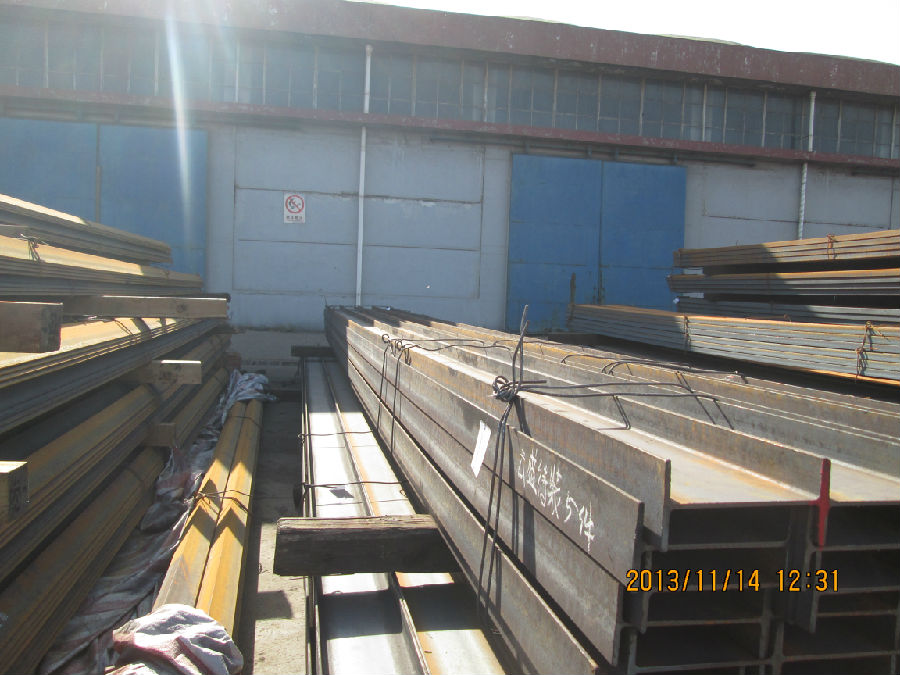
Packaging & Delivery of Hot Rolled Steel H-beam
1. Packing: it is nude packed in bundles by steel wire rod
2. Bundle weight: not more than 3.5MT for bulk vessel; less than 3 MT for container load
3. Marks:
Color marking: There will be color marking on both end of the bundle for the cargo delivered by bulk vessel. That makes it easily to distinguish at the destination port.
Tag mark: there will be tag mark tied up on the bundles. The information usually including supplier logo and name, product name, made in China, shipping marks and other information request by the customer.
If loading by container the marking is not needed, but we will prepare it as customer request.
4. Transportation: the goods are delivered by truck from mill to loading port, the maximum quantity can be loaded is around 40MTs by each truck. If the order quantity cannot reach the full truck loaded, the transportation cost per ton will be little higher than full load.
5. Delivered by container or bulk vessel
Production flow of Hot Rolled Steel H-beam
Material prepare (billet) —heat up—rough rolling—precision rolling—cooling—packing—storage and transportation
- Q:How do steel H-beams perform in structures with large openings and openings for services?
- Steel H-beams are highly versatile and perform exceptionally well in structures with large openings and openings for services. Their inherent strength and structural integrity make them ideal for supporting heavy loads and spanning wide gaps without compromising stability. Additionally, H-beams can easily accommodate openings for services such as electrical, plumbing, or HVAC systems, allowing for efficient integration of utilities within the structure.
- Q:What are the different types of steel H-beam connections used in seismic design?
- In seismic design, there are several types of steel H-beam connections commonly used to provide structural stability and resistance against earthquakes. These connections are designed to ensure the transfer of forces and loads between different structural members, such as beams and columns, while maintaining the overall integrity of the structure. Some of the commonly used H-beam connections in seismic design include: 1. Welded Connections: Welded connections are widely used in seismic design due to their simplicity and effectiveness. The H-beam flanges and web are welded together to create a strong and rigid connection. This type of connection can resist both axial and lateral forces, making it suitable for seismic applications. 2. Bolted Connections: Bolted connections involve the use of high-strength bolts to join the H-beam components together. This type of connection provides ease of assembly and disassembly, which can be advantageous during construction or retrofitting. Bolted connections are designed with proper bolt pre-tensioning to ensure sufficient strength and stiffness. 3. Extended End-Plate Connections: Extended end-plate connections are commonly used in seismic design when higher resistance against lateral forces is required. In this type of connection, the end-plate is extended beyond the H-beam flanges and is bolted to the column or another beam. The extended end-plate provides additional rigidity and strength to resist seismic forces. 4. Reduced Beam Section (RBS) Connections: RBS connections are specifically designed to maintain the overall structural integrity during a seismic event by dissipating the earthquake energy. In this type of connection, a portion of the H-beam flange is removed, creating a weak section that will yield and absorb seismic forces, protecting the rest of the structure. RBS connections are commonly used in moment-resisting frames to avoid brittle failures. 5. Seismic Shear Tabs: Seismic shear tabs are small steel plates welded to the H-beam flanges and connected to the supporting structure, such as columns or walls. These tabs increase the shear capacity of the connection and help distribute the lateral forces during an earthquake. Seismic shear tabs are often used in combination with other connection types to enhance the overall seismic performance of the structure. It is important to note that the selection of the appropriate H-beam connection type in seismic design depends on various factors, including the structural system, load requirements, and specific seismic design criteria. Structural engineers and designers carefully consider these factors to determine the most suitable connection type for each application, ensuring the safety and stability of the structure under seismic conditions.
- Q:300 * 150 * 6.5 * 9 H steel is used as steel beam, span 6 meters, spacing 2 meters, laying steel plate, 15 cm soil
- Deduct the weight of beam combination value of 1.35 * 0.373=0.5 (KN/m) 23.41-0.5=22.91.. The equivalent loads of 22.91 * 2=45.82 (KN/m -). While the 150 thick reinforced concrete, (omitted plate weight) 0.150 * 25.1=3.77 (KN/m -). 45.82-3.77=42.05 (KN/m -). This is the bearing capacity calculation of beam.
- Q:What is the fire rating of steel H-beams?
- The fire rating of steel H-beams typically depends on various factors such as the size and thickness of the beam, the type and thickness of any fire-resistant coatings or treatments applied to the beam, and the overall fire protection system in place. Generally, steel is considered to have inherent fire-resistant properties compared to other building materials such as wood. However, without additional fire protection measures, steel H-beams can lose their load-bearing capacity in high temperatures due to thermal expansion and structural deformation. To improve the fire resistance of steel H-beams, fire protection measures can be implemented, including fire-resistant coatings or fireproofing materials that are applied to the surface of the beams. These coatings or materials are designed to provide a certain level of fire resistance by retarding the heat transfer and delaying the point at which the steel reaches its critical temperature. The fire rating assigned to steel H-beams will depend on the specific fire protection measures employed. Fire ratings are typically expressed in terms of time, such as 30 minutes, 60 minutes, 90 minutes, or 120 minutes, indicating the duration for which the steel beams can withstand fire exposure without significant loss of structural integrity or load-bearing capacity. It is essential to consult with fire protection engineers, architects, and relevant building codes or standards to determine the appropriate fire rating for steel H-beams in a specific application.
- Q:What are the considerations when designing for natural disaster planning in Steel H-Beams?
- When designing for natural disaster planning in Steel H-Beams, there are several considerations to keep in mind. Firstly, it is crucial to understand the specific requirements and regulations set by local building codes and standards for structural resilience against natural disasters such as earthquakes, hurricanes, or floods. These codes often include guidelines for material strength, connections, and overall structural stability. Additionally, the design should account for the potential impact of extreme environmental conditions on the steel beams, such as high winds, heavy rain, or seismic forces. Engineers should consider factors like load-bearing capacity, deflection, and buckling resistance to ensure the beams can withstand the expected forces and remain intact during a natural disaster. Furthermore, proper connections and detailing of the steel H-beams are vital to ensure the overall structural integrity. The design should incorporate appropriate joint connections, such as welding or bolted connections, to ensure that the beams can effectively transfer forces and resist any sudden movements or displacements caused by the disaster. Lastly, regular inspections, maintenance, and repairs should be included in the design considerations. These measures help to ensure the ongoing safety and reliability of the steel H-beams, as any damage or deterioration can compromise their performance during future natural disasters. In summary, when designing for natural disaster planning in Steel H-Beams, it is essential to adhere to local building codes, consider the impact of extreme environmental conditions, incorporate proper connections and detailing, and prioritize ongoing maintenance and inspections.
- Q:Can steel H-beams be used for long-span structures?
- Long-span structures can indeed utilize steel H-beams. These beams are widely employed in construction owing to their exceptional strength-to-weight ratio and versatility. They possess the capability to span considerable distances without necessitating supplementary support columns or beams. The H-shaped design ensures structural stability and even distribution of the load, rendering them suitable for long-span structures such as bridges, high-rise buildings, and industrial facilities. Moreover, steel H-beams can be easily fabricated and interconnected, facilitating efficient construction and customization to meet specific design requirements. Overall, steel H-beams are a highly favored option for long-span structures due to their robustness, endurance, and cost-effectiveness.
- Q:What's the difference between welded H - section steel and high frequency welded H - section steel and hot rolled H section steel?
- There are hot forming and welding composite forming the two modes of production of H steel. The welding of H steel is the appropriate thickness strip is cut into the appropriate width of welding machine will edge and waist are welded together in the continuous welding of H steel metal consumption, production and economic benefits is low, not easy to guarantee products the performance of the uniform. Therefore, the main difference between the H type steel production in rolling mode of.H type steel and ordinary I-beam in rolling on, the latter can be rolled in two roll rolling, the former need in the universal pass. The hot-rolled H steel near net shape continuous casting billet, through four roller universal rolling process the production of high quality, high efficiency, low consumption, low cost and other characteristics, in improving the steel quality and enhance the use of economic benefit has great superiority.
- Q:Are steel H-beams resistant to corrosion or rust?
- Yes, steel H-beams are generally resistant to corrosion or rust due to the protective layer formed by their zinc coating or other anti-corrosion treatments.
- Q:What are the different types of coatings available for fire protection of steel H-beams?
- Fire protection coatings for steel H-beams come in several different types, each designed to enhance fire resistance and prevent weakening or collapse during a fire event. The most commonly used type is intumescent coatings. These coatings contain special chemicals that expand when exposed to heat, creating a charred layer that insulates the steel and slows heat transfer. They provide excellent fire resistance and can withstand high temperatures for an extended period. Another type is cementitious coatings, made from a mixture of cement, fillers, and binders. These coatings form a hard, durable layer that acts as a heat barrier. They are thick, providing good fire resistance, and are also resistant to impact and abrasion, making them suitable for high-risk areas. Reactive coatings are also available. These coatings contain chemicals that react at high temperatures, releasing fire-retardant gases or water vapor. This reaction cools down the steel and prevents it from reaching critical temperature. Reactive coatings are effective in providing fire resistance and are often used in areas with limited space for insulation. Vermiculite coatings consist of lightweight, granular material mixed with a binder and sprayed onto steel beams. When exposed to heat, vermiculite expands, forming an insulating layer that protects the steel. This type of coating is ideal for buildings where weight is a concern, as it is lightweight and adds minimal load to the structure. Intumescent paint is a type of fire protection coating that expands like foam when exposed to high temperatures. It is applied like regular paint and creates a layer that insulates the steel and slows down heat transfer. Intumescent paint is commonly used in areas where aesthetics are important, as it comes in various colors and finishes. It is important to consider factors such as required fire rating, duration of fire resistance, environmental conditions, and specific application when choosing a coating. Consulting a fire protection engineer or specialist is recommended to determine the most suitable coating for a specific project.
- Q:Are steel H-beams resistant to fire?
- Yes, steel H-beams are highly resistant to fire. Due to their high melting point and excellent structural integrity, steel H-beams can withstand high temperatures and maintain their strength even during a fire. This makes them a popular choice for structural support in buildings and other fire-prone environments.
1. Manufacturer Overview |
|
|---|---|
| Location | |
| Year Established | |
| Annual Output Value | |
| Main Markets | |
| Company Certifications | |
2. Manufacturer Certificates |
|
|---|---|
| a) Certification Name | |
| Range | |
| Reference | |
| Validity Period | |
3. Manufacturer Capability |
|
|---|---|
| a)Trade Capacity | |
| Nearest Port | |
| Export Percentage | |
| No.of Employees in Trade Department | |
| Language Spoken: | |
| b)Factory Information | |
| Factory Size: | |
| No. of Production Lines | |
| Contract Manufacturing | |
| Product Price Range | |
Send your message to us
High Quality Hot Rolled Steel Jis Standard H Beam
- Loading Port:
- Tianjin
- Payment Terms:
- TT OR LC
- Min Order Qty:
- 25 m.t.
- Supply Capability:
- 1000 m.t./month
OKorder Service Pledge
OKorder Financial Service
Similar products
New products
Hot products
Related keywords
